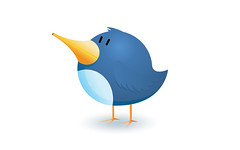
Social Networking:
A Management Tool
Lately I've been interested in social networking tools, both for getting (and keeping) a job, and as a potential tool for pulling together work teams and speeding up feedback loops. I've come to see that CG supervisors and producers need to embrace these tools for both reasons. By embrace, I mean use and master.
My journey into these tools began long ago, because I'm going to expand my definition to embrace not only tools like Twitter, LinkedIn, Facebook, Spacebook and so forth, but also tools like Google Docs, Calendars, Basecamp and other applications that foster communication and collaboration.
Email is perhaps the most familiar and most ancient of the tools available. Overtime, email users have developed some cultural guidelines for how to use email effectively. However, I believe that how and when we use email will radically shift as more people begin to rely on the new social networking tools.
Now, by new, I mean the tools that have been emerging over the last few years. Today I want to talk about the tool I think has the most power and potential for us: Twitter. You may ask, why Twitter and not Facebook, MySpace or LinkedIn?
Twitter differs from the other applications in a significant way: it is essentially a super-group-chat, and the primary use of Twitter is to hold conversations within a community of users.
Facebook and MySpace are excellent, general purpose, social networking apps. I haven't jumped into MySpace, but Facebook's terms of service restrict it's use to non-commercial networking, so it's a place to connect with friends and family. However, Facebook gives professionals and businesses a "page", with most of the features of a Facebook account, including a wall. I use one to separate my personal and professional networks: Isa A Alsup, but the way I use it is redundant to my Twitter site. I just want to reach my professional contacts that haven't jumped into Twitter or LinkedIn.
Sites like LinkedIn and VFXConnection aim at building professional networks. LinkedIn is very restrictive about attempting to link in people you don't know, while VFXConnection seems to have no restrictions. On the other hand, LinkedIn seems vast with members and groups, while VFXConnection is less so. But VFXConnection has more services, including a job board and resume posting, so it's sort of a hybrid social networking and job site. Both offer groups, and this is a good way to extend your professional contact list.
You may think networking is just about finding a job, but it's much more than that. But let's start there. If you're not sure about the importance of professional or career networking, I suggest you finish this article, thenimmediately go to the blog of The Career Coach, Pamela Kleibrink Thompson published on the Animation World Network, http://www.awn.com/. Pamela points up the foolishness of "Working Without a Net(work)" and provides valuable guidance in her column. Sooner or later you will need a new job, and 80% of jobs, she points out, are never advertised.
Almost 80% of jobs are never advertised
--Cornell University Career Services,
attributed by Pamela Kleibrink Thompson
attributed by Pamela Kleibrink Thompson
Using network tools to find a job are outside the scope of this blog, which is why I refer you to Pamela. Monster.com also has great articles, but Pamela is the Master of Masters when it comes to coaching careers. The important point here is to build your network now and work it now. Follow Pamela's advice about how to network without becoming a leech or nuisance by using your network to contribute to helping others. As the movie title goes, Pay It Forward.
Helping others and getting help are the way you can and will use your network most of the time. Joel Comm, in his book "Twitter Power", reminds us that the most important part of the word "network" is the "work". It's not enough to click a few links and collect a bunch of connections. You need to work to give value to the connections, by answering questions and being supportive. On LinkedIn, don't wait to be asked for recommendations, give them. When asked, give. Give, give, give. The act of giving and receiving in a social network requires a conversation to occur. In fact, sometimes the gift is the conversation: for example, when you offer support, praise or answer a question. An inexpensive but valuable gift.
And this is why I believe that our best tool for social networking isn't email, or blogging, or building connections, it's having conversations. Enter Twitter, which fosters and enables conversations. Sure, you can use Facebook or LinkedIn or even email, but nothing is as simple and as effective as Twitter.
Get out there and build a social network, get in the conversation, and help one another. Join professional groups in LinkedIn and start using Twitter to build and maintain connections within the CG and VFX community. Certainly tell us what you're doing now, and add what you're thinking about, feeling, reading, inspired by, and would like to do. Ask questions and give answers. Be a friend. Give help, and ask for help. You'll thank me later.

Use Twitter At Work
You spend a huge part of your day having conversations as a CG Supervisor or producer. Most of these will be with subordinates and a few with superiors and if you are very lucky, a tiny fraction with peers.
Recently, I managed a CG department with 36 employees. One day my boss called me and asked me to come across the street to his office. I immediately stopped what I was doing and headed for the door. Between the phone and the door, three floors down, I had no less than seven conversations in the next few minutes --all about ongoing projects. By the time I walked half a block to the crossing, crossed and made it to the other building I had another conversation with a worker who came with me (to continue the conversation) and another on my cell phone. The entire day was one conversation after another.
What are we talking about? Everything. Status on shots. Notes I need addressed. Status on source materials. Vacation request. An artist is again asking for Photoshop. Someone missed a deadline. Materials for next week's episode are late. Scheduling a meeting. Network issues. A shader problem. Do I like the lighting? Lunch. Hiring. Someone leaving. A camera move. Are these waves OK? Look at this cool stereographic image I made using projection mapping. Is the model approved..... On and on and on.
This was my day, exhausting and stimulating. I managed a crew of 36 at peak, most of the time closer to 20. Three subordinate supervisors and two coordinators carried a heavy load, so I did not have to handle everything. Imagine a bigger crew, perhaps even scattered on many floors (I only had two floors to deal with) or several buildings or more than one city? Email may be a good way to stay in touch, and there are other tools we will look at like Basecamp, Shotgun, Google Apps, and the like, but for many communications, Twitter (or a tool like it) may be the answer.
In a nutshell, you need to set up a Twitter account separate from your personal account. It could be for your CG company, division or department or team. It could be for one or more projects. The fun thing, is you get to decide.
Say your company is producing at any given time four films, and your crew is mostly assigned to one film, although a few rare specialists may be assigned to two films. The CG Supervisor or Producer or Coordinator for the film sets up a protected Twitter account, where only approved people may follow the tweet timeline. This is vital to meet any non-disclosure agreements your company is obliged to follow. Then users would set-up a separate work Twitter account and follow the project.
And there you are. All your status reports from all team members are flying around where whoever needs the information has it. Coordinators can see it. You can ask so and so to follow up. A question about a shader. A comment on a camera move. Information is moving. You're conversing. And further, you're able to record the conversations.
Other tools exist to organize the conversation, and we will look at these in the context of how they will support the approval and material pipeline. But for your everyday, simple to use and easy to setup tool, Twitter is the tool for your Production Pipeline.
A few caveats: it may be a protected conversation, but in the workplace, not every conversation is for all ears! Vacation requests and anything personal should be handled in a private channel, either a private chat or better an email or whatever form your company policy dictates. Some conversations should not be written, and others must always be written or somehow recorded. Very sensitive matters, like employee discipline, should be witnessed by another supervisor. All this is outside the realm of Twitter.
rule
not every conversation is for all ears!
rule
In the workplace, use Twitter to praise. Have a private conversation to rebuke. Use it to guide individuals and build the team. Promote some casual talk, but don't let it become a chat and gossip pool. Build morale and team spirit. Use it to make group announcemen, remind people about deadlines. Use it to communicate all those things that email is just not efficient at.
A final word: Twitter is a social networking tool. Like any tool, you need to learn to use it and learn to use it well. Get a good book, I recommend Joel Comm's Twitter Power, but there are others for Twitter and for other tools. (I'm currently reading LinkedWorking by Frank Agin and Frank Howes).
I strongly recommend adding Twitter to your internal communications network and to your personal professional network. If you do use it at work, please follow me and let me know how it goes.
I wish I had been using it on my last job and will use it in the future.
![Reblog this post [with Zemanta]](http://img.zemanta.com/reblog_c.png?x-id=908cbaa3-2bab-499c-b3ec-721a41d3f059)





0 comments:
Post a Comment